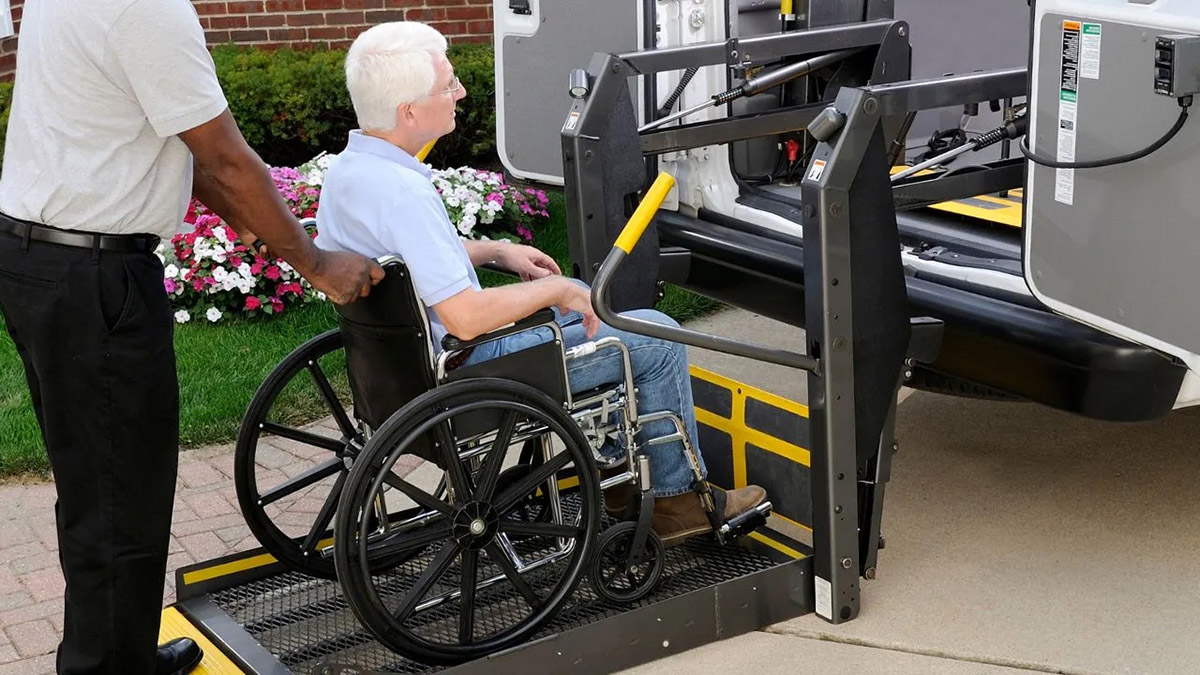

Finance
Why Is NEMT Insurance So Expensive
Published: November 21, 2023
Looking for answers on why NEMT insurance is costly? Gain insights from our finance experts and discover ways to manage expenses effectively.
(Many of the links in this article redirect to a specific reviewed product. Your purchase of these products through affiliate links helps to generate commission for LiveWell, at no extra cost. Learn more)
Table of Contents
- Introduction
- Factors Affecting NEMT Insurance Costs
- Rising Medical Costs and Liability Risks
- Specialized Fleet and Vehicle Coverage
- Increased Demand and Limited Competition
- Regulatory Compliance and Safety Requirements
- Claims and Lawsuits in the NEMT Industry
- Importance of Comprehensive NEMT Insurance
- Strategies to Manage NEMT Insurance Costs
- Conclusion
Introduction
Non-Emergency Medical Transportation (NEMT) services play a vital role in providing transportation for individuals with disabilities or medical conditions who require assistance travelling to medical appointments, therapies, or routine healthcare visits. However, while the demand for NEMT services continues to rise, so does the cost of insurance coverage for NEMT providers and operators. The high cost of NEMT insurance is a growing concern for the industry, and understanding the factors that contribute to this expense is crucial for both providers and insurance companies.
Insurance for NEMT services is essential as it provides coverage for liability risks, property damage, medical expenses, and legal claims that may arise during transport operations. Providers are legally obligated to carry appropriate insurance coverage to protect both their passengers and themselves. However, this insurance can be significantly more expensive than standard commercial auto insurance due to the unique risks associated with NEMT operations.
There are several factors that contribute to the high cost of NEMT insurance, including rising medical costs and liability risks, the specialized fleet and vehicle coverage required, increased demand and limited competition, regulatory compliance and safety requirements, and the frequency of claims and lawsuits in the NEMT industry. Understanding these factors is essential for NEMT providers, as it allows them to develop strategies to manage insurance costs while maintaining a high level of service and compliance.
In this article, we will explore each of these factors in detail, highlighting their impact on the cost of NEMT insurance and the importance of comprehensive coverage. We will also provide strategies for NEMT providers to effectively manage their insurance costs while ensuring the safety and well-being of their passengers. By understanding the nuances of NEMT insurance and implementing proactive measures, providers can navigate the challenges of rising insurance costs and continue delivering essential transportation services to those in need.
Factors Affecting NEMT Insurance Costs
Several key factors contribute to the high cost of insurance for Non-Emergency Medical Transportation (NEMT) services. These factors include rising medical costs and liability risks, the specialized fleet and vehicle coverage required, increased demand and limited competition, regulatory compliance and safety requirements, and the frequency of claims and lawsuits in the NEMT industry.
Firstly, the rising cost of medical care and liability risks in the healthcare industry directly impact the cost of NEMT insurance. NEMT providers are responsible for transporting individuals with various medical conditions and disabilities, and in the event of an accident or injury during transport, the potential for medical expenses and legal claims can be substantial. As medical costs continue to rise, insurance companies must account for these potential expenses when pricing NEMT insurance policies.
Secondly, the specialized fleet and vehicle coverage required for NEMT services contribute to the higher costs of insurance. Unlike standard commercial auto insurance, NEMT providers must have vehicles that are equipped to transport individuals with medical equipment, mobility aids, and specialized seating. These modifications and additions to the vehicles increase their value and make them more expensive to insure.
Additionally, the increased demand for NEMT services coupled with limited competition in the insurance market contributes to the higher costs. As the population ages and people require more access to medical services, the demand for NEMT has skyrocketed. However, the insurance market for NEMT providers is relatively niche, with fewer insurers specializing in this particular industry. The lack of competition leads to higher premiums being charged by insurance companies.
Furthermore, regulatory compliance and safety requirements add to the overall cost of NEMT insurance. NEMT providers must adhere to strict regulations and safety guidelines to ensure the well-being and security of their passengers. This includes comprehensive background checks for drivers, vehicle inspections, regular training for medical equipment handling, and other safety protocols. The cost of maintaining and implementing these safety measures is passed on to the providers through higher insurance premiums.
Finally, the frequency of claims and lawsuits in the NEMT industry significantly affects insurance costs. NEMT providers may face liability claims due to accidents, injuries caused during transport, or allegations of negligence. These claims can result in substantial financial loss for the insurance companies, leading to higher premiums to compensate for potential payouts.
Overall, the combination of rising medical costs, specialized vehicle coverage, limited competition, regulatory compliance, and the frequency of claims and lawsuits all contribute to the high cost of insurance for NEMT services. Providers must carefully assess and manage these factors to ensure they have comprehensive insurance coverage while mitigating costs where possible.
Rising Medical Costs and Liability Risks
One of the primary factors contributing to the high cost of insurance for Non-Emergency Medical Transportation (NEMT) services is the rising cost of medical care and the associated liability risks within the healthcare industry.
As healthcare costs continue to escalate, so do the potential expenses associated with any medical incidents that may occur during NEMT operations. NEMT providers are responsible for transporting individuals with varying medical conditions and disabilities, and in the unfortunate event of an accident or injury during transport, the resulting medical expenses can be substantial. Insurance companies must account for these potential costs when pricing NEMT insurance policies, leading to higher premiums for providers.
Liability risks also significantly impact the cost of NEMT insurance. Providers face potential legal claims and lawsuits if they are found liable for any harm or injury that occurs during transport. These claims can arise from accidents, physical discomfort resulting from transportation, or allegations of negligence in providing appropriate care during the journey.
The litigation costs associated with defending against these claims and potential settlements can be exorbitant. Insurance companies factor in the likelihood of these risks and set premiums accordingly to protect themselves financially. The increasing frequency of lawsuits in the NEMT industry further contributes to the rising insurance costs.
Moreover, the nature of the NEMT industry itself poses unique challenges and increased liability risks. Transporting individuals with medical conditions or disabilities can involve handling medical equipment, administering medication, managing mobility aids, and ensuring proper care throughout the journey. This specialized care carries inherent risks, and any failure to meet these obligations can result in legal consequences.
To mitigate these rising medical costs and liability risks, it is crucial for NEMT providers to prioritize safety and implement comprehensive risk management practices. Thoroughly vetting and training drivers, ensuring proper maintenance of vehicles, and adhering to industry regulations can help minimize the potential for accidents and injuries during transportation.
Additionally, establishing clear policies and protocols for handling medical emergencies, conducting regular safety audits, and staying up to date with best practices in patient care can further reduce liability risks. By demonstrating a commitment to safety and providing quality care, NEMT providers can potentially negotiate lower insurance premiums with their insurers.
Ultimately, the rising cost of medical care and liability risks within the healthcare industry significantly impact the cost of insurance for NEMT services. Providers must remain vigilant in risk management strategies to minimize potential incidents and demonstrate their commitment to safety. By doing so, they can effectively navigate the challenges posed by rising insurance costs while ensuring the well-being of their passengers.
Specialized Fleet and Vehicle Coverage
One of the factors that contribute to the high cost of insurance for Non-Emergency Medical Transportation (NEMT) services is the need for specialized fleet and vehicle coverage. Unlike standard commercial auto insurance, NEMT providers must have vehicles that are specifically modified and equipped to transport individuals with medical conditions and disabilities.
The modifications required for NEMT vehicles often include wheelchair lifts or ramps, securement systems to safely transport individuals using wheelchairs or mobility aids, and specialized seating arrangements to accommodate medical equipment or assistive devices. These modifications not only increase the value of the vehicles but also add complexity to the insurance coverage.
Insurance companies consider the cost of these modifications and specialized equipment when determining the premiums for NEMT providers. The higher the value of the vehicles and the more intricate the modifications, the greater the potential cost for repairing or replacing them in the event of an accident or damage.
Furthermore, the nature of transporting individuals with medical conditions and disabilities introduces additional liability risks. In the event of an accident or injury during transport, the potential for medical expenses and legal claims rises. Insurance companies factor in these increased risks when pricing the specialized fleet and vehicle coverage for NEMT providers.
Additionally, NEMT vehicles are subject to additional wear and tear due to the nature of their operations. Constantly loading and unloading passengers, securing mobility aids, and accommodating medical equipment can lead to more frequent vehicle maintenance and repair needs. These additional maintenance costs are taken into account by insurance companies when determining premiums.
Since NEMT vehicles are highly specialized and not typically used for other commercial purposes, the pool of insurance providers offering coverage for these vehicles is smaller. Limited competition in the market further drives up the cost of the specialized fleet and vehicle coverage for NEMT providers.
To manage the high cost of specialized fleet and vehicle coverage, NEMT providers can take proactive measures. Regular maintenance and inspections of vehicles are crucial to ensure they remain in good condition and reduce the risk of accidents or breakdowns. Proper storage and security measures can also deter theft or vandalism, which would otherwise increase insurance costs.
Additionally, providers should consider seeking insurance quotes from multiple companies specializing in NEMT coverage. By comparing different policies, providers may be able to identify more competitive options that still meet their coverage needs.
In summary, the need for specialized fleet and vehicle coverage significantly contributes to the high cost of insurance for NEMT services. The value of modified vehicles, increased liability risks, additional maintenance and repair requirements, and limited competition in the insurance market all drive up the premiums for these types of policies. However, NEMT providers can mitigate these costs by maintaining their vehicles properly, implementing security measures, and exploring insurance options from different providers.
Increased Demand and Limited Competition
The high cost of insurance for Non-Emergency Medical Transportation (NEMT) services can be attributed, in part, to the increased demand for these services coupled with limited competition in the insurance market. As the population ages and the need for medical care and transportation services increases, the demand for NEMT has skyrocketed.
The surge in demand for NEMT services has led to a higher risk exposure for insurance companies. More operations and trips mean a greater likelihood of accidents or incidents occurring during transport, which in turn increases the potential for insurance claims. To compensate for this higher risk, insurance companies tend to charge higher premiums to NEMT providers.
Furthermore, the NEMT insurance market is relatively niche, with fewer insurance companies specializing in providing coverage for this specific industry. The limited competition within the market allows insurers to set higher prices, knowing that there are fewer alternatives available to NEMT providers.
Without many options to choose from, NEMT providers may find themselves paying higher premiums simply due to the lack of competition among insurance providers. This limited pool of insurers means that providers may have fewer opportunities to negotiate lower rates or find more affordable coverage options.
However, NEMT providers can take certain steps to mitigate the impact of increased demand and limited competition on insurance costs. Building strong relationships with insurance brokers who specialize in the NEMT industry can be advantageous. These brokers have in-depth knowledge of the market and can help providers navigate the insurance landscape effectively.
Providers can also explore alternative insurance strategies, such as joining industry groups or associations that offer group insurance programs. These programs leverage the collective buying power of multiple providers to negotiate more favorable insurance rates and coverage options.
Additionally, maintaining a strong safety and compliance record can help NEMT providers demonstrate their commitment to risk management practices. Insurance companies may be more willing to offer competitive premiums to providers who can showcase their efforts to maintain a safe and secure transportation operation.
Lastly, it is crucial for NEMT providers to stay informed and aware of developments within the insurance market. Monitoring insurance trends, regulatory changes, and emerging insurance options can help providers identify new opportunities for more affordable coverage.
While the increased demand for NEMT services and limited competition in the insurance market contribute to the high cost of insurance, providers can still take proactive measures to manage these costs effectively. Partnering with specialized insurance brokers, exploring group insurance programs, prioritizing safety and compliance, and staying informed about insurance market developments are all crucial steps to balance the financial aspects of offering NEMT services.
Regulatory Compliance and Safety Requirements
Regulatory compliance and safety requirements in the Non-Emergency Medical Transportation (NEMT) industry are essential factors that contribute to the high cost of insurance. NEMT providers must adhere to strict regulations and safety guidelines to ensure the well-being and security of their passengers.
One of the primary reasons for the stringent regulations is the vulnerability of the passengers being transported. Many NEMT passengers have medical conditions or disabilities that require specialized care and attention during transit. To protect these individuals, regulatory agencies put in place measures to ensure that NEMT providers meet certain standards to guarantee passenger safety.
For example, comprehensive background checks for drivers are required to ensure they have a clean driving record and do not pose a risk to passengers. Moreover, drivers often need to receive specific medical transportation training to familiarize themselves with proper care and assistance techniques for passengers with unique needs.
Additionally, vehicles used for NEMT must meet specific standards and undergo regular inspections. These requirements can include proper maintenance and servicing, ensuring the presence of necessary medical equipment, and verifying wheelchair accessibility and securement systems.
In order to maintain regulatory compliance and meet safety requirements, NEMT providers must allocate resources towards training, vehicle modifications, and routine maintenance. While these measures are crucial for maintaining the highest level of passenger care and safety, they also contribute to the overall cost of insurance.
Insurance companies consider the extent to which providers meet regulatory and safety requirements when determining premiums. Providers who demonstrate a strong commitment to compliance and safety may have lower insurance costs compared to those who do not prioritize these aspects.
However, some NEMT providers may incur higher insurance expenses if they have a history of non-compliance and safety issues. Insurance companies may view these providers as higher-risk clients, resulting in higher premiums to offset the potential liability associated with their operations.
To manage costs related to regulatory compliance and safety requirements, NEMT providers should prioritize a culture of safety within their organization. This includes regular training sessions for drivers and staff, implementing safety protocols and procedures, and conducting routine audits to identify any areas that may need improvement.
Providers should also maintain open communication and cooperation with regulatory agencies to stay updated on any changes in regulations or new compliance requirements. This proactive approach can help providers adapt swiftly and ensure ongoing adherence to regulations.
Ultimately, regulatory compliance and safety requirements are vital in the NEMT industry to protect the well-being and security of passengers. While meeting these requirements may contribute to the cost of insurance, providers who prioritize safety and compliance can mitigate potential liability risks and potentially negotiate lower insurance premiums.
Claims and Lawsuits in the NEMT Industry
The Non-Emergency Medical Transportation (NEMT) industry is not immune to claims and lawsuits, which significantly impact the cost of insurance for providers. The frequency of claims and lawsuits in this industry can be attributed to a variety of factors, including the unique risks associated with transporting individuals with medical conditions or disabilities.
One of the primary reasons for claims and lawsuits in the NEMT industry is accidents during transportation. Despite safety measures and precautions, accidents can still occur, leading to injuries or property damage. The potential for medical expenses, legal claims, and settlements resulting from these accidents contributes to higher insurance costs for NEMT providers.
In addition to accidents, claims and lawsuits can also arise from allegations of negligence or improper care during transportation. NEMT providers have a duty of care towards their passengers and must ensure their safety and well-being throughout the journey. Any perceived failure to meet these obligations can result in legal consequences.
Furthermore, the vulnerable nature of NEMT passengers increases the likelihood of claims and lawsuits. Many individuals utilizing NEMT services have underlying medical conditions or disabilities, making them more susceptible to accidents, injuries, or complications during transport. In some cases, patients may hold the provider responsible for exacerbating existing medical conditions or for not providing the appropriate level of care.
Other factors that contribute to claims and lawsuits in the NEMT industry include issues with scheduling, missed appointments, equipment malfunctions, and delays in transportation. Any disruption in service or perceived negligence during these instances can give rise to legal actions.
The impact of claims and lawsuits in the NEMT industry extends beyond the immediate financial burden. Providers must allocate resources towards legal representation, settlements, and potential damage to their reputation. Additionally, insurance companies may increase premiums for providers who have a history of claims and lawsuits due to the higher risk associated with their operations.
To manage the impact of claims and lawsuits, NEMT providers should prioritize risk management and implement thorough safety protocols. This includes comprehensive driver training, regular vehicle maintenance, proper documentation of all incidents and procedures, and clear communication with passengers regarding expectations and limitations.
Providers should also work closely with insurance brokers or companies specializing in NEMT coverage. These experts can help assess potential risks, recommend strategies to minimize liability, and navigate the claims process should an incident occur.
Ultimately, while claims and lawsuits in the NEMT industry can contribute to the high cost of insurance, providers can mitigate these risks through proactive risk management, robust safety procedures, and collaboration with insurance professionals. By prioritizing passenger safety and providing excellent care, NEMT providers can minimize the frequency and severity of claims and lawsuits, thus helping to control insurance costs.
Importance of Comprehensive NEMT Insurance
Comprehensive insurance coverage is of paramount importance for Non-Emergency Medical Transportation (NEMT) providers. NEMT services involve transporting individuals with varying medical conditions and disabilities, and the potential risks and liabilities associated with this responsibility necessitate robust insurance coverage.
First and foremost, comprehensive NEMT insurance provides protection against potential accidents or incidents during transportation. Medical emergencies can occur unexpectedly, and it is crucial that NEMT providers have insurance coverage that encompasses medical expenses, property damage, and liability claims resulting from such incidents.
Comprehensive insurance coverage also safeguards NEMT providers against allegations of negligence or improper care during transport. The nature of NEMT services requires providers to meet the unique needs of each passenger and ensure their safety and well-being throughout the journey. In the event of a claim or lawsuit, comprehensive insurance coverage can provide the necessary legal representation and financial support to defend against such allegations.
Moreover, comprehensive NEMT insurance offers protection against theft, vandalism, and damage to vehicles or medical equipment. NEMT providers invest in specialized vehicles and equipment to accommodate the unique needs of their passengers. In the event of theft, vandalism, or accidents that result in damage, comprehensive insurance coverage provides the financial resources to repair or replace these assets.
Another aspect to consider is the potential for interrupted operations due to unforeseen circumstances. Comprehensive insurance coverage can include coverage for business interruption, reimbursing providers for lost revenue during periods when their services are temporarily halted due to accidents, damages, or other covered events.
Besides the financial protection it offers, comprehensive insurance coverage also instills confidence in passengers and their families. Knowing that the NEMT provider has adequate insurance coverage reassures passengers that their well-being and safety are prioritized. This can contribute to positive customer experiences and enhance the provider’s reputation within the community.
It is essential for NEMT providers to carefully review their insurance policies and ensure that all necessary coverage is in place. General commercial auto insurance may not offer the specific protections required for NEMT operations. Engaging with insurance brokers or companies specializing in NEMT coverage is crucial to properly assess the unique risks and requirements of the industry.
In summary, comprehensive NEMT insurance is indispensable for providers. It provides protection against accidents, medical emergencies, property damage, liability claims, theft, and interruption of operations. By having robust insurance coverage in place, NEMT providers can operate with confidence, protect their assets, and deliver essential transportation services to individuals with medical conditions or disabilities.
Strategies to Manage NEMT Insurance Costs
Managing insurance costs is crucial for Non-Emergency Medical Transportation (NEMT) providers to maintain financial stability while ensuring the provision of high-quality services. While insurance is a necessary expense, there are strategies providers can employ to mitigate the impact of escalating insurance costs.
1. Shop around and compare quotes: It’s essential for NEMT providers to explore multiple insurance options and obtain quotes from different providers. By comparing policies and premiums, providers can identify competitive rates and coverage options that best meet their needs.
2. Develop a strong safety culture: Demonstrating a commitment to safety can help NEMT providers secure more favorable insurance rates. Implementing rigorous safety protocols, conducting regular driver training, and maintaining a clean safety record can all contribute to lower insurance costs.
3. Implement risk management practices: By actively managing risks, NEMT providers can minimize the likelihood of accidents, incidents, and claims. Proper vehicle maintenance, regular inspections, and thorough documentation of safety procedures can all help reduce insurance costs by showing a proactive approach to risk management.
4. Consider higher deductibles: Choosing a higher deductible can lower the upfront insurance premium. However, providers should evaluate their risk tolerance and financial capabilities before opting for a higher deductible as it would mean higher out-of-pocket expenses in the event of a claim.
5. Join industry groups or associations: NEMT providers can explore opportunities to join industry groups or associations that offer group insurance programs. These programs leverage the collective bargaining power of multiple providers to negotiate more favorable insurance rates and terms.
6. Review and update insurance coverage regularly: NEMT providers should regularly reassess their insurance coverage needs and communicate changes to their insurance companies. As the business evolves and expands, it’s crucial to ensure that the insurance coverage adequately reflects the current operations and potential risks.
7. Invest in driver training and education: Well-trained drivers can contribute to safe and secure transportation, which can ultimately lead to lower insurance costs. Providing ongoing training and education for drivers on topics such as defensive driving, patient care, and proper handling of medical equipment can help mitigate risks and reduce insurance expenses.
8. Utilize telematics and technology: Implementing telematics devices and utilizing technology can help monitor and improve driver behavior, vehicle maintenance, and overall operational efficiency. Insurance companies may offer discounts or incentives for adopting technology that enhances safety and risk management practices.
9. Maintain a good claims history: A history of frequent claims can lead to higher insurance premiums. Providers should focus on preventing accidents, responding promptly to incidents, and properly documenting and reporting claims to maintain a positive claims history.
10. Engage with an experienced insurance broker: Working with insurance brokers who specialize in NEMT coverage can provide valuable insights and assistance in navigating the insurance landscape. These experts can provide guidance on risk management strategies and help secure the most cost-effective insurance policies.
Implementing these strategies can help NEMT providers proactively manage their insurance costs while maintaining a high level of service and compliance. By being proactive and attentive to risk management practices, providers can mitigate potential liabilities and secure more favorable insurance premiums without compromising the quality of care provided to their passengers.
Conclusion
The high cost of insurance for Non-Emergency Medical Transportation (NEMT) services is a significant concern for providers in the industry. However, by understanding the factors that contribute to these expenses and implementing effective strategies, NEMT providers can manage insurance costs while maintaining the essential transportation services they offer.
Rising medical costs and liability risks, the specialized fleet and vehicle coverage required, increased demand and limited competition, regulatory compliance and safety requirements, and the frequency of claims and lawsuits all contribute to the high cost of NEMT insurance. These factors highlight the unique challenges faced by NEMT providers in protecting their passengers, assets, and businesses.
Comprehensive insurance coverage is crucial for NEMT providers, as it provides protection against accidents, property damage, liability claims, theft, and interruptions to operations. It also instills confidence in passengers and their families, knowing that their well-being and safety are prioritized by the provider.
Providers can employ various strategies to manage insurance costs effectively. Shopping around for insurance quotes, developing a strong safety culture, implementing risk management practices, considering higher deductibles, joining industry groups or associations, and regularly reviewing and updating insurance coverage are all effective measures to mitigate insurance expenses. Additionally, investing in driver training, utilizing telematics and technology, maintaining a good claims history, and engaging with experienced insurance brokers can contribute to cost management strategies.
In conclusion, NEMT providers must prioritize comprehensive insurance coverage to safeguard their operations, passengers, and assets. By understanding the factors influencing high insurance costs and implementing proactive strategies to manage expenses, providers can strike a balance between cost control and the delivery of quality NEMT services. Through effective risk management practices and proactive measures, NEMT providers can navigate the challenges of rising insurance costs while ensuring the safety and well-being of the individuals who rely on their transportation services.














